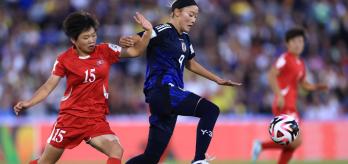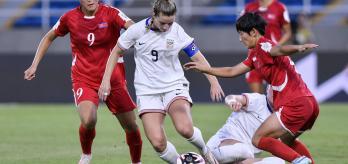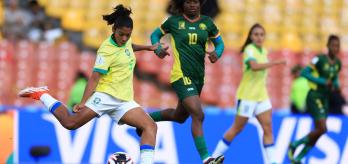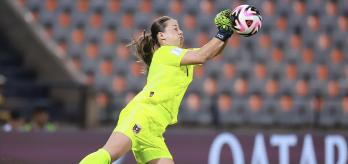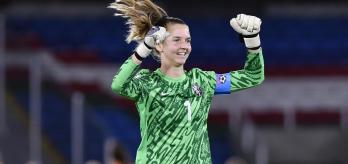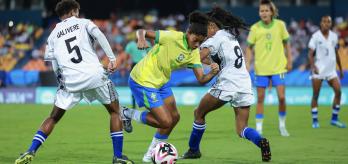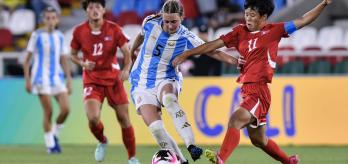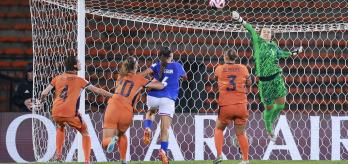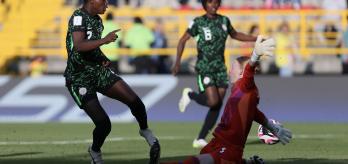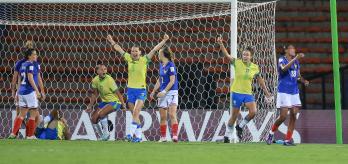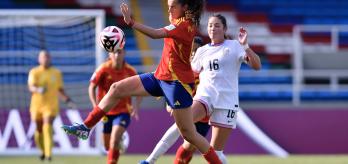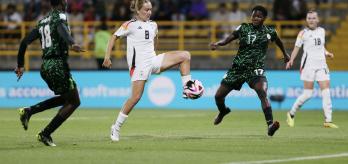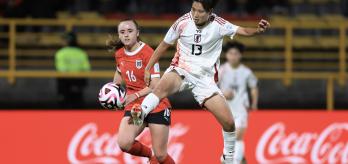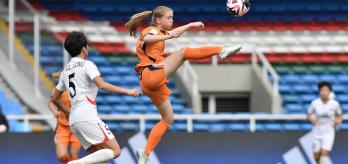Stellar performances, excellent judgements, presence, impressive technique and bravery were just some of the characteristics demonstrated by the Netherlands’ 19-year-old goalkeeper, Femke Liefting, as she claimed the adidas Golden Glove award for the FIFA U-20 Women’s World Cup Colombia 2024™.
Our TSG noted her mindset in high-pressure situations, and how this influenced her team-mates, breeding confidence with her decision-making both in and out of possession. Her performance levels were consistently high throughout the tournament, while she produced some big saves in huge moments of important games, including saving two shoot-out penalties in their quarter-final victory over host nation Colombia in front of a sellout home crowd.
Off the pitch, she proceeded with two hours of school study per day during the competition, confessing that mathematics is her favourite subject. It is therefore not surprising that she showed a high level of composure and logic when calculating what to do in different situations.
In this article, TSG member Pascal Zuberbühler highlights two aspects of Liefting’s game that reflected her ability and influence.
Out of possession
Defending the space outside the penalty area
A key feature of Liefting’s role in the team was her ability to support her defensive line and defend the space outside her penalty area. Her judgement and understanding of when to stay and defend her goal, and when to come out and defend the space impressed our TSG.
According to Zuberbühler, “The first thing the goalkeeper must assess is whether the player on the ball can take a strike at goal. If they can, then it is clear they must defend their goal. They can defend the space afterwards, but in that moment, the priority must be defending the goal. However, there are times in a game when the goalkeeper can, and must, take responsibility for the space outside their penalty area.”
When the goalkeeper’s defensive line is in danger of being breached, there are a number of factors they must recognise and understand when considering an interception outside their penalty area, as Zubi explains.
“The first important thing is the position of the ball and the orientation of the player who has the ball. Once the goalkeeper is satisfied that they cannot make an attempt at goal, they must assess the positions of any supporting attackers and their positions in relation to her own defenders. Can the ball be played to another player who could open up a more dangerous part of the pitch?
“In these situations, the cognitive ability of the goalkeeper is crucial as they must be able to read the scenario and perceive the trajectory of the ball. Does it travel on the ground or in the air as both methods demand different responses. The speed at which the ball travels is also a factor, particularly in relation to the attacking runs of supporting opposition players. Goalkeepers have many factors to consider in these types of situations and must be able to assess, interpret and decide quickly.
“Once a decision is made to go to the ball (or to stay), the action takes priority, and this is where the quality of their first steps becomes very important because the timing of any intervention outside of the penalty area is vital. Is the goalkeeper going to recover the ball and start a build-up sequence or are they looking to make a timely clearance in advance of an opponent getting to the ball? Is the ball coming on the ground or in the air? The technical gesture must always be adapted to the situation and to the specific requirements of the action,” he added.
As we can see, interventions outside the penalty can be quite complex but this was an area of goalkeeping where Liefting really excelled. As we can see in the graphic below, she faced 17 through-ball situations, 13.3 more than the tournament average of 3.7, with four of these coming outside the penalty area. Liefting made a total of 8 clearances, 6.6 more than the tournament average of 1.4, highlighting her presence, decision-making and effectiveness in these situations.
Zuberbühler uses three clips below to highlight examples of how Liefting commanded the space outside her penalty area.
“In clip 1, her starting position was great. She was observing and scanning and could see that France winger Aïrine Fontaine (11) could not score a goal from her position. Once the through ball was played, she judged the situation perfectly, taking explosive first steps, and fully committed to making the intervention, while factoring in and understanding the run of their striker. This was a very well-timed clearance.
“In clip 2, Liefting shows brave and strong decision-making, but again, it all comes from her starting position. Her team loses the ball when Japan right-back Rio Sasaki (6) intercepts and has controlled possession on the halfway line. Liefting judges that she cannot score from there and scans the situation ahead of her. When the ball is played around her defensive line, it’s a difficult one for her and she holds her position until she sees that her defender cannot get to the ball. At this point, she makes the decision to come out and this is brilliant judgement and timing. Her reading of the situation was excellent, and she had courage, determination and presence in how she came and made the clearance.
“Finally, in clip 3, Liefting’s awareness of the situation is very strong once more. She scans the pitch and recognises the explosive pace of the USA’s attacker, Taylor Suarez (14), understanding that she is likely to break the defensive line with her speed. If she stayed in her penalty area, it is clear it would be a 1v1 situation, but she assesses the danger quickly and decides to come out, making a brave clearance with a perfectly timed intervention. This is high-level goalkeeping,” Zubi added.
In Possession
Distribution into
When the Netherlands had the ball, Liefting demonstrated her ability to break lines of the opposition’s defensive structure by recognising opportunities to play balls into team-mates, according to Zuberbühler.
“We could see that she understood the game and could read the situations. Even before she received the ball, she knew where the space was and where her team-mates were positioned because she was scanning the pitch. She also recognised the right opportunities to play directly into a team-mate, and when to play into space so a team-mate could exploit it. This level of decision-making and technical execution is high for such a young player.”
Before the goalkeeper receives the ball, they must know the picture in front of them and what options are available to them. Once they receive the ball, they must quickly re-assess the situation before playing their pass, to ensure their timing is right. Is the picture still the same? Does the situation warrant a quick, first-time ball into a player or space, or can they take a touch and make eye contact with a team-mate to indicate their intentions, so they can time their movements to receive?
“These are also important things to look at in this situation,” Zubi notes. “The timing from the goalkeeper is crucial because they could release a player quickly who might have a favourable 1v1 or 2v1 situation, or they may need to take the extra touch to give a team-mate time to get into a favourable position. Once the decision is made to play into a team-mate, then it is all about the technical execution of that pass. The timing, weight, trajectory, and pace of the pass are all crucial to ensure the player receiving can secure, retain, or progress the ball.”
When compared to the tournament averages for goalkeepers that featured in Colombia, it is clear to see how strongly Liefting performed, completing 100% of her attempted passes around the opposition’s team shape and 100% of her line breaks around.
Below, Zuberbühler has selected three examples of Liefting’s distributions into her team-mates to highlight the key aspects of her decision-making and technical execution.
In clip 4 against Japan, Liefting plays short but immediately scans the pitch in anticipation of receiving the ball. Her body position is open as she offers to receive and takes a touch with her right foot to evade incoming pressure. She then demonstrates how comfortable she is playing off both feet by playing a beautifully controlled lofted pass forward into space, where her forward player can come to receive the ball.
In clip 5 against the USA, she recognises a great opportunity to break lines with a lofted pass into her centre-forward. First, she offers to receive and has an open body shape to ensure she can get a full picture of the pitch. By scanning like this, she can see her forward player available in the space between the USA’s midfield and defensive lines as she makes an offer to receive. Liefting knows this will be her next pass before she receives the ball and she takes her first touch to tee up this pass and double-checks that it is still on. Once she decides to play the pass, she weights the ball perfectly with her right foot, lofting it over two lines of the USA’s defensive shape and into the space for Robine Lacroix (10) to receive.
In clip 6, from a goal kick, again we see how she uses an open body shape to scan the pitch allowing her to spot Lacroix (10) in space. Under no pressure, she has time to consider her pass and weights it perfectly with her right foot, breaking lines and allowing her team-mate to receive in the space.
Key Take-aways
Liefting brought confidence to her defenders with her dominant presence, courageous decision-making, and decisive action, both in and out of possession. Her game awareness, cognitive function and timing meant she was assertive when defending the space both inside and outside of her penalty area.
When in possession, she scanned the pitch to assess the positioning of her team-mates and to understand where the space was when considering which passes she could execute to break lines. The 19-year-old goalkeeper demonstrated real maturity and bravery in her decision-making and in the execution of goalkeeping actions. Her sense of composure in vital moments of important games meant she had a big influence in her team’s progress in the competition.






